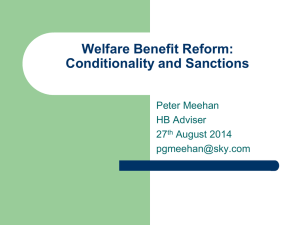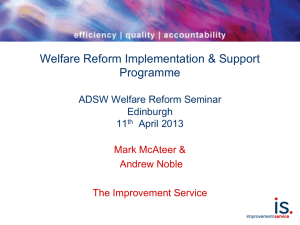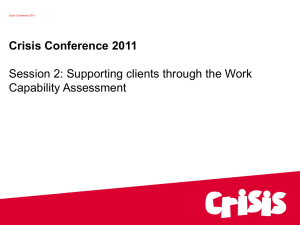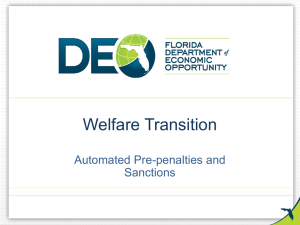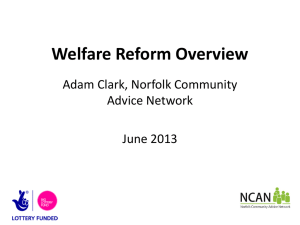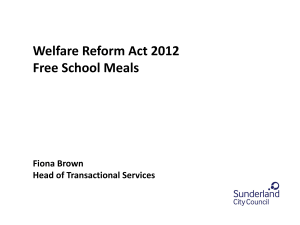Presentation: Progress, Challenges and the "Claimant Commitment"
advertisement
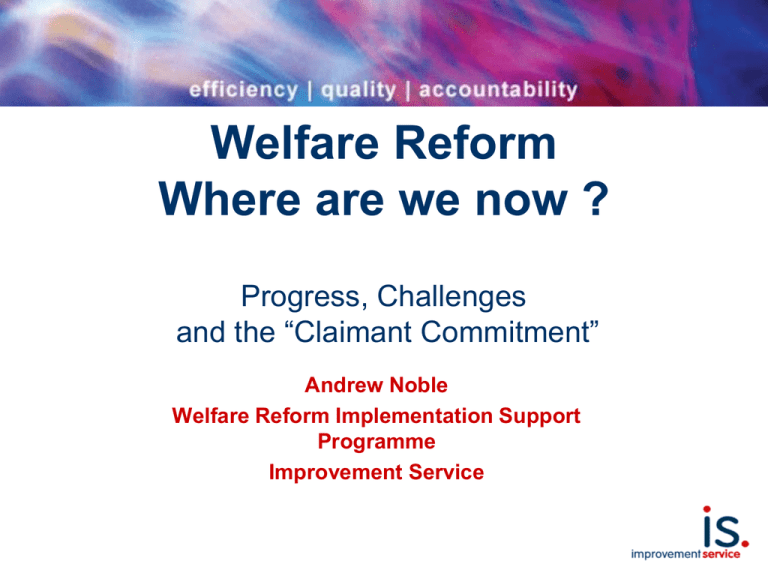
Welfare Reform Where are we now ? Progress, Challenges and the “Claimant Commitment” Andrew Noble Welfare Reform Implementation Support Programme Improvement Service Purpose of day To enable elected members to: • review the progress of Welfare Reform to date • consider the potential impact and challenge of the new Claimant Commitment and sanctions policy • Hear about ongoing work to mitigate and respond to Welfare Reform • consider the specific roles and challenges for elected members in responding to the reform agenda to date, and in the future Welfare Reform- the story so far Implementation and impact of key reforms• Universal Credit • Personal Independence Payment • Under occupancy- “the bedroom tax” • Discretionary Housing Payments (DHP) expansion • Benefit Cap, • Scottish Welfare Fund • Council Tax Reduction Scheme- National scheme in place. Welfare Reform- the story so far • Delay in roll out of Universal Credit (UC) and Personal Independence Payments(PIP)- the cornerstone Reforms. • UC will not now roll out in Scotland till early 2016, beyond a single Jobcentre in Inverness • PIP roll out has started on a phased geographic basis in Scotland • Significantly diverging approaches between Scottish Government and UK Government/ DWP- Funding to mitigate in Scotland • Negotiations ongoing between CoSLA and DWP over a range of issues- LSS, SFIS, HB administration costs etc. • Growing evidence impact on Local Authorities, RSLs and partners Welfare Reform Impact on Scotland Cumulative proportion of total Profile of Total Changes to Scottish Welfare Budget 2010-11 to 2014-15 100% 100% 80% 55% 60% 40% 20% 24% 1% 7% 0% 2010-11 2011-12 2012-13 2013-14 2014-15 Financial impacts Total Changes to Scottish Welfare Budget 2010-11 to 2014-15 (£M) Notes: ‘Other’ category includes Benefit Cap, DLA, ESA, etc. All figures derived from HMT/DWP forecasts, which estimate over £4.5 billion worth of cuts in Scotland -2,000 -1,500 -1,000 -500 Underoccupancy charge Tax Credits 1,000 -1,770 -590 -1,700 State pension & pension credit Other 500 -70 Child Benefit Uprating changes - 590 -1,150 Group Discussion 1: How is your local authority responding to Welfare Reform? What are the significant challenges you face? Session 2 Claimant Commitment and Sanctions Background- Conditionality and Sanctions • Conditionality has always existed in the Welfare system rules have been increasingly tightened since 2008 • Sanctions have increased in duration and severity since the 1990s (1995 Jobseekers Act) • Introduction of the Claimant Commitment in October 2013 for JSA • Building on the conditionality regime introduced for JSA and ESA in October 2012. Claimant Commitment How it works • Each Claimant Commitment is to be individually tailored to the needs of the claimant- agreed between the claimant and their jobcentre advisor/ Job coach • Claimant Commitment determined by an initial assessment by JC+ • Intended by DWP to make it absolutely clear what is required of them in return for their benefits. • Policy change in advance of the introduction of Universal Credit • Major feature of DWP’s drive to change “behaviour and culture” Claimant Commitment • What is expected of the Claimant: • • • • • • • Actively look for work Attend JC+ Interviews Participate in mandatory employment programmes Ready for work immediately Work full time Take a job at minimum wage Prepared to travel up to 90 minutes from home to work Sanctions • What happens if you don’t meet the Conditionality requirements of your benefit claim: • Potential to be “sanctioned”- lose your benefit payments for a period of time • Three levels of sanction- low medium and high • Can lose benefit for anything between 4 weeks and 3 years. • Sanctions can be reconsidered, appealed and claimants can receive a hardship payment Types of Sanction Sanction level Reason Low • Failure to attend an adviser/ job coach interview • Refusal to carry out a jobseeker direction • Failed to participate in a mandatory employment programme (the Work Programme) Intermediate • Not actively seeking work • Not being available for work High • Losing employment voluntarily • Losing employment through misconduct • Refusal of employment • Refusal to participate in mandatory work activity Example of a JSA sanction Claimant “A” refused an offer of employment, which is classified as a “high” level failure. As this is the second failure within a 52 week period, Claimant “A” receives a sanction of 26 weeks removal of JSA. Sanctions • Scottish Government analysis of the research shows: • Claims who face sanctions are often unable rather than unwilling to comply with sanctions. Those particularly vulnerable to sanctions are the most disadvantaged Younger people tend to receive a higher proportion of sanctions Impact of Sanctions is mixed- may improve short term outcomes in terms of leaving unemployment and entering employment However research suggests that these individuals tend not to enter sustainable employment and the tend to have low incomes. Also a range of related negative outcomes • • • • • What has actually been happening? JSA Sanctions in Scotland 2012-13 • DWP has released data on JSA sanctions which cover the period October 2012- September 2013: • • • 177,449 JSA sanction decisions in Scotland during this time period 75,329 (42%) of these decisions were “adverse”. 43,705 (25%) sanctions decisions were “cancelled decisions” • • • 41,112 (54%) were low level sanctions 26,820 (36%) were intermediate level sanctions 7,360 (10%) were high level sanctions • • • 48,951 separate individuals were subject to an adverse sanction decision 28,623 adverse decisions were asked to be reconsidered, 38% of the total 1,751 adverse decisions were appealed against, 2% of the total. JSA Sanctions Oct.12-Sept.13 West Lothian West Dunbartonshire Stirling South Lanarkshire South Ayrshire Shetland Islands Scottish Borders Renfrewshire Perth & Kinross Orkney Islands North Lanarkshire North Ayrshire Moray Midlothian Inverclyde Highland Glasgow City Fife Falkirk Eilean Siar Edinburgh, City of East Renfrewshire East Lothian East Dunbartonshire East Ayrshire Dundee City Dumfries & Galloway Clackmannanshire Argyll & Bute Angus Aberdeenshire Aberdeen City 7197 4550 3344 9373 3235 169 2171 6057 JSA Adverse Sanction Decisions 3458 194 5559 All JSA Sanction Decisions 14706 5194 1944 3250 3255 4559 27166 15038 6922 393 15280 1608 2732 2038 4060 9035 3633 3214 2170 3908 3119 6052 0 5000 10000 15000 20000 25000 30000 % of JSA sanction decisions resulting in an adverse decision (Oct 2012-Sept 2013) 56 56 Shetland Islands Inverclyde East Renfrewshire South Ayrshire Renfrewshire North Ayrshire East Ayrshire Dumfries & Galloway Highland West Dunbartonshire East Dunbartonshire Eilean Siar Glasgow City Argyll & Bute Clackmannanshire Moray Aberdeenshire Midlothian Scottish Borders Angus Falkirk South Lanarkshire Perth & Kinross West Lothian Fife East Lothian Dundee City North Lanarkshire Edinburgh, City of Aberdeen City Stirling Orkney Islands 53 50 50 50 49 49 48 48 47 47 44 43 43 43 42 42 41 40 40 40 40 39 39 38 38 38 37 37 36 36 0 10 20 30 40 50 60 JSA Sanctions- UK analysis • Some findings emerge from the published data from October 2012 September 2013 • • UK analysis- University of Glasgow (D Webster, 19/2/14) Total number of JSA sanctions in this period- 874,850, the highest since JSA introduced in 1996. 527,574 individuals received a sanction. Again the highest level of individual sanction since 1996. JSA claimants sanctioned at a rate of 5.11% per month, and in the 3 months to September 2013 the rate was 6% per month. Highest rate since JSA introduced. Failure to participate in training/ employment schemes and “not actively seeking work” are now the main reasons for JSA sanctions. Twice as many people on the Work Programme are getting a sanction as opposed to a job outcome Tribunals are upholding almost 9 out of 10 appeals against DWP. Only 2.44% of those sanctioned are going to tribunal however. • • • • • Impact • What does this mean • Increased claimant work search activity and requirement to find work • Increased service demand for Councils across a wide range of services- response to Claimant Commitment • Increasing number and severity of sanctions- hardship, crisis, negative outcomes? • Policy change in advance of UC- in advance of any funding package around the Local Support Service Framework- Council’s and partners taking the financial and demand hit Key challenges • How do local authorities work with Jobcentre Plus/ DWP to minimise negative impact of a tougher sanctions regime? • Effects of more people looking for and getting work? • Is the help available for the people who need it most? • What outcomes are we trying to achieve? getting people off benefit or getting them into work is not the same thing • Local authorities and their partners picking up the service demand and the crisis- direct challenge to early intervention, prevention model of public service delivery? • In-Work conditionality is a feature of Universal Credit- will effect millions of low pay/ part time employees as UC is rolled out. Group Discussion 2: • What is the Elected Member role in relation to conditionality and sanctions? • Are there other key challenges? • How can Local Authorities work most effectively to minimise potential negative outcomes from sanctions? Session 3 Responding to Welfare Reform Scottish Government ResponseMitigation • £258 million in mitigation funding in the period 2013-14 to 2015-16 In 2013-14 this included: • £20m for Discretionary Housing Payments • £23m for Council Tax Reduction Scheme • £33m for Scottish Welfare Fund (£23.8m transferred by DWP, £9.2m in SG funding) • £7m for advice, support and anti-poverty projects Conditionality and Sanction Working with CoSLA and Scottish Government: • Survey of all 32 local authorities • Trying to get a clearer idea of the impact and effect of claimant conditionality and sanctions on the ground • On-line survey with 4 themes: • Impact on service demand • Information and data collection • Impact on client experiences • Council responses Survey will underpin the ongoing discussions around policy and practice in this area. Discussions at a regional and national level with the DWP Local Authority Pilots 3 Scottish Government pilots during 2013-14, • Aberdeenshire, Dundee City, South Lanarkshire Draft evaluation findings include: • Substantial deficit in IT skills, experience and confidence among benefit claimants • Ongoing commitment on the part of Council’s required to support people through online claiming process • Important to work closely with trusted 3rd sector/ community organisations • Training and information for front line staff is key • Need to promote new/ changed services effectively • Some citizen’s will always require substantial support • Focus on restructuring and aligning key service areas Welfare Reform Resilience Fund • Scottish Government £600,000 fund available to local authorities during 2014-15. Principles of prevention, early intervention 1. Innovative and transformational projects with the potential to inform development/ service redesign 2. Projects which will mitigate negative impacts of welfare reform 3. Projects which demonstrate a partnership approach • Application closing date, 24th April. Projects start May 2014 Local Support Services • DWP term to describe additional services that will be required for Universal Credit (and that they are prepared to fund as a result) – Triage – Online access – Personal budgeting • LA’s and other agencies deliver services such as employability, which are LSS but not in the DWP framework • DWP to undertake “trialling and testing” with local Local Support Services • UK wide agreement that DWP will work with LA’s to develop LSS • Scotland will have its own OPA(Overarching Partnership Agreement) with DWP • LA’s will have DPA’s with JC+ Districts (Delivery Partnership Agreement) • LSS will be designed, delivered and managed through CPP structures with Jobcentre+ • Negotiations ongoing at a national level around this and the associated funding for LSS Welfare Reform Data Dashboard Neighbourhood Level Map Group Discussion 3: How do Councils their partners and Councillors best mitigate the impact of Welfare Reform? What are the main opportunities from Welfare Reform and how do we progress these? What further support do Elected members require to appropriately respond to Welfare Reform Conclusions, final reflections, feedback and evaluation Welfare Reform Implementation Support Programme andrew.noble@improvementservice.org.uk
